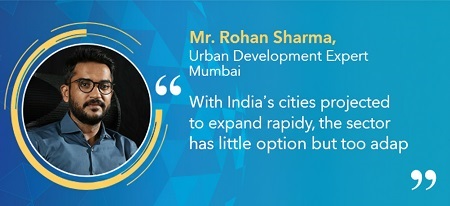
Rakesh Reddy, Director, Aparna Constructions shares his views about the nation’s massive demand for affordable housing while also ensuring that new construction aligns with sustainability goals.
India’s real estate sector growth must meet the nation’s massive demand for affordable housing while also ensuring that new construction aligns with sustainability goals. Industry leaders and policymakers alike agree that the solution lies in integrating affordability, green building practices, and supportive regulations into one cohesive strategy.
The demand for affordable housing continues to be unrelenting. Urbanisation, rising household numbers, and aspirations for homeownership continue to strain supply in cities across the country. While government-backed initiatives have helped improve access in recent years, the need far outpaces delivery. For many families, affordability goes beyond the initial price of a home and also includes the cost of maintaining it over time.
This is where sustainability emerges as a key differentiator. Features like energy-efficient design, smart water management, and natural ventilation not only promote greener living but also help households substantially cut down on utility costs. No longer just a selection of eco-friendly amenities, green housing solutions is becoming an economic necessity. Lower electricity and water costs directly benefit families in affordable housing segments.
Also Read: Top 10 Indian Real Estate Leaders Redefining Affordable Housing
Policy is playing a crucial role in enabling this transformation. State governments and urban local bodies have begun to offer incentives such as faster clearances, reduced fees, and additional development rights for projects that adopt sustainable practices. At the same time, mandatory energy codes and building standards are raising the bar across the sector. As alignment between central schemes and state-level policies improves, adoption of green housing will accelerate.
Technology is also reshaping how projects are built. Prefabricated components, modular construction, and digital design tools are enabling developers to cut costs and timelines while reducing waste. New materials, including low-carbon cement and recycled aggregates, are gradually entering the mainstream, promising further savings and sustainability as scale improves.
 Challenges, however, are present. Smaller developers often struggle with the upfront costs of incorporating green features, and financing options for sustainable construction are limited. Also, buyers may be unaware of the long-term financial benefits of green homes, making it more difficult to justify higher initial prices. Improving consumer awareness and offering tailored green finance products are needed to bridge the gap.
Challenges, however, are present. Smaller developers often struggle with the upfront costs of incorporating green features, and financing options for sustainable construction are limited. Also, buyers may be unaware of the long-term financial benefits of green homes, making it more difficult to justify higher initial prices. Improving consumer awareness and offering tailored green finance products are needed to bridge the gap.
The long-term advantages of affordable, sustainable housing are both significant and compelling. It reduces strain on urban infrastructure, helps cities manage resources more efficiently, and improves resilience to climate-related risks. Families benefit from lower maintenance costs and healthier living environments, while municipalities see reduced pressure on energy and water systems.
Also Read: 5 Sustainable Green Building Consultants in India to Know
With India’s cities projected to expand rapidly, the sector has little option but to adapt. The future of the real estate sector lies in projects that are simultaneously affordable and sustainable, supported by consistent policy and innovative construction methods.
We use cookies to ensure you get the best experience on our website. Read more...
Copyright © 2025 HomesIndiaMagazine. All Rights Reserved.